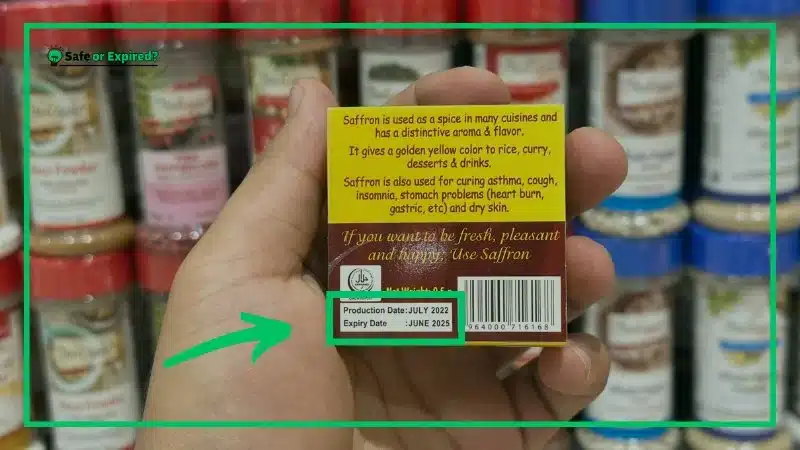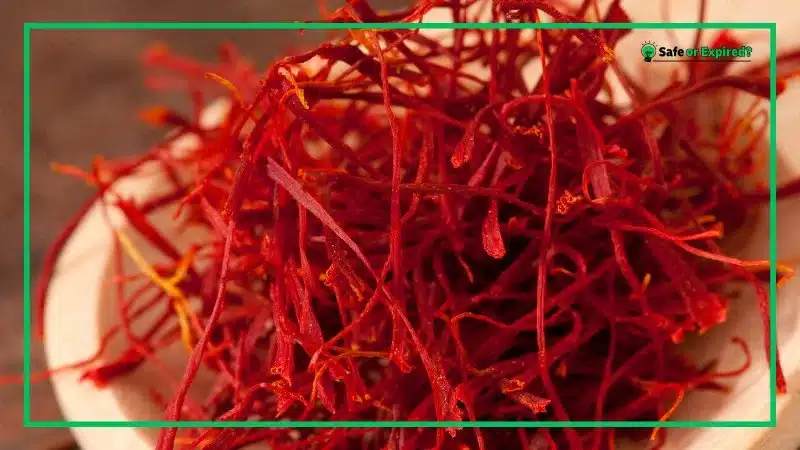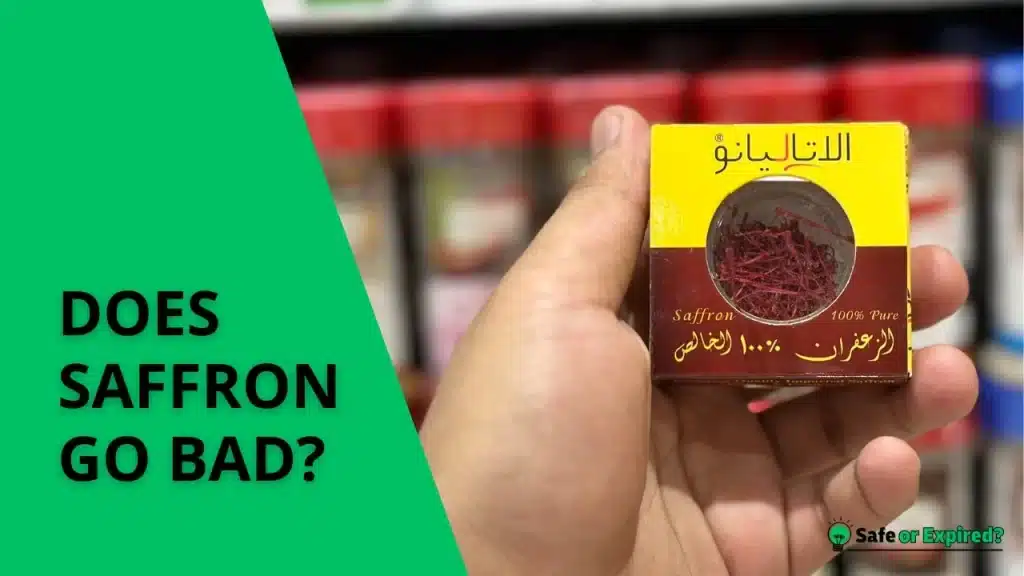“Does saffron go bad?” is a vital question for culinary enthusiasts who value premium spices. Yes, it can lose its flavor and aroma over time, but with proper storage, its life can be greatly extended.
In this article, we’ll explore effective methods to keep your Saffron vibrant and flavorful. Stick to the end.
Does Saffron Go Bad? Ultimate Guide
Yes, Saffron can go bad, but it takes a long time. Properly stored Saffron maintains its quality for about three to five years. However, its potency and aroma gradually decline. Therefore, it’s recommended to use saffron before the date printed on its packaging.

People often ask, “Does unopened saffron go bad?” Unopened Saffron, when stored correctly, can last several years without spoiling. It does not typically go bad but may lose some of its potent flavor and color over time. The key is to store it in airtight containers in a cool, dark environment.
You may also want to know, “Does saffron go bad in fridge?” Storing Saffron in the fridge can help extend its shelf life. In the fridge, Saffron stays fresh for about three to five years if kept in an airtight container. The cool temperature helps preserve its vibrant color and distinct flavor longer than at room temperature.

Many people also search “Does saffron have an expiration date?” Saffron does not have a traditional expiration date, but it is best used within 3 to 5 years. After this period, it might still be safe to use, but its quality in terms of taste and aroma will diminish.
How Long Does Saffron Go Bad? Factors Affecting the Shelf Life
Saffron typically lasts 3 to 5 years when stored properly. Beyond this, it may not spoil but will lose potency and flavor. The key to preserving Saffron’s quality lies in its storage conditions and some other factors. Check out which ones affect the shelf life of Saffron:
Storage Conditions
The environment where Saffron is stored plays a crucial role. It should be kept in a cool, dark, and dry place. Exposure to heat, light, or moisture can accelerate the degradation process, reducing its shelf life significantly.
Quality of Saffron
The initial quality of the Saffron also affects its longevity. High-grade Saffron with less moisture content will last longer than lower-quality strands that might already have higher moisture levels. You can read all about the moisture content (and other nutritional facts) by examining the bottle.
Packaging
Proper packaging is essential to extend Saffron’s life. Airtight containers are ideal because they prevent moisture and air exposure, both of which can lead to faster deterioration of the saffron strands.
Handling Practices
Frequent handling or exposure to air when opening the container can also reduce the shelf life of Saffron. Minimal handling and keeping the container sealed when not in use are best practices for maintaining quality.
Now, you can ensure that your Saffron remains potent and flavorful for as long as possible.
The Side Effect of Expired Saffron – What To Expect?
Using expired Saffron typically does not pose health risks but may result in a less effective flavor and aroma. Expired Saffron loses its potency, which means it won’t enrich dishes as intended. Let’s now look at all the effects of using expired Saffron:
Reduced Flavor Impact
When Saffron expires, its most significant impact is on its flavor. Saffron is prized for its unique, potent taste and aroma, which can significantly enhance a variety of dishes, from rice to desserts.
However, once it expires, these properties diminish. This means you might need to use more Saffron to achieve the desired flavor, which is not cost-effective. Additionally, the subtle nuances that high-quality Saffron brings to dishes will be lost, resulting in less flavorful meals.
Loss of Aroma
Saffron’s aroma is just as important as its taste. An expired saffron will have a less pronounced scent, which reduces the overall sensory experience of the dishes it is used in. The aromatic compounds in Saffron degrade over time, especially if not stored properly.
This degradation leads to a flat, less vibrant scent, meaning that the Saffron’s ability to contribute to the dish’s aroma is significantly reduced.
Color Dilution
One of the key attributes of Saffron is the golden-yellow hue it imparts in recipes. As saffron ages and moves past its prime, its coloring capabilities weaken. This results in dishes that are paler than expected.
For recipes where Saffron’s color is pivotal, such as in risotto alla Milanese or paella, using expired Saffron could lead to visually underwhelming results, affecting the overall appeal of the dish.
Economic Waste
Using expired Saffron can also be considered economically inefficient. Since expired Saffron has reduced effectiveness, you might end up using a larger quantity to try and mimic the flavor, aroma, and color of fresh Saffron.
This can quickly become costly, as Saffron is one of the most expensive spices in the world. Moreover, the results still won’t match the quality provided by fresh Saffron, potentially leading to wasted ingredients and effort.
By understanding these effects, consumers can better decide when to replace their Saffron to maintain the quality of their culinary creations.
Now, let’s discuss popular queries related to the side effects of Saffron:
Is 10 Year Old Saffron Harmful?
No, 10-year-old Saffron is not harmful. Saffron does not spoil in a way that makes it unsafe to consume, even after many years. However, its quality, including aroma, flavor, and color, will diminish over time.
Is 20-Year-Old Saffron Harmful?
No, 20-year-old Saffron is not harmful to consume. Like other dried spices, Saffron does not develop harmful bacteria or toxins, but it will lose much of its potency and effectiveness over a long period.
Can We Use Expired Saffron?
Yes, you can use expired Saffron. It is not harmful as it doesn’t spoil in a way that produces dangerous toxins. The main consequence of using expired Saffron is a decrease in its flavor, color, and aroma.
People also ask, “Can we use expired saffron on face?” Yes, expired Saffron can be used on the face without harm. While its effectiveness may be reduced, expired Saffron still retains antioxidant properties that can benefit the skin, such as reducing inflammation and enhancing glow. Ensure it hasn’t developed mold or an unusual odor before use.
Does Dried Saffron Go Bad? Everything to Know
Dried Saffron does not go bad in the traditional sense, but it does lose potency over time. Properly stored, it can retain quality for 3 to 5 years. After this, it gradually loses its flavor and aroma, though it remains safe to use.
Wondering, “How long does dried saffron last?” Dried Saffron can last up to 3 to 5 years if stored correctly.
It’s important to differentiate fact from fiction in food preservation. Discover the truths in “10 Common Myths About Food Preservation Uncovered” to avoid common mistakes.
Does Saffron Water Go Bad?
Saffron water does go bad and should be used within 1 to 2 days when stored in the refrigerator. Unlike dried Saffron, saffron-infused water is perishable and can develop bacteria if left at room temperature for too long.
Do Saffron Threads Go Bad?
Saffron threads, like dried Saffron, don’t go bad but will lose their effectiveness over time. With proper storage—cool, dark, and dry—they can maintain peak quality for about 3 to 5 years. After this, they’re still safe but less potent.
Here’s a simple table that outlines the typical shelf life of Saffron under different storage conditions. This will help you understand how long you can expect your Saffron to stay fresh and effective:
| Type of Saffron | Shelf Life at Room Temperature | Shelf Life in Refrigerator | Shelf Life in Freezer |
| Whole Saffron Threads | 3-5 years | 5-7 years | Up to 10 years |
| Ground Saffron | 1-2 years | 2-3 years | 3-4 years |
| Saffron Extract | 1-2 years | 2-3 years | 3-4 years |
| Saffron Infused Products (e.g., saffron water) | 1-2 days | 3-5 days | Not recommended |
Ensuring the safety of your food is crucial. Read about the “Key Safety Guidelines from Leading Food Safety Institutions” to stay informed on best practices.
How To Know Saffron Is Expired? 3 Signs
To determine if Saffron is expired, check for a loss in aroma, faded color, and a lackluster flavor. While Saffron doesn’t spoil like fresh produce, these spoilage signs indicate that it has lost its potency and will not effectively flavor or color your dishes.
Loss of Aroma
One of the first signs that Saffron is past its prime is a significant reduction in its aroma. Fresh Saffron should have a rich, distinct smell that is slightly sweet and earthy.
If you open your container of Saffron and can’t smell much, it’s likely that the Saffron is too old to deliver its full benefits. This is because the essential oils that provide the aroma have evaporated over time, leaving the threads less vibrant in both scent and taste.
Faded Color
Saffron’s vibrant, deep red-orange color is another indicator of its freshness. Over time, the color of saffron threads may become noticeably lighter or faded, which is a sign that the spice is losing its potency.
The color comes from the crocins within Saffron, which are responsible not only for its hue but also for some of its health benefits. A paler color suggests that these compounds are degrading, and with them, the overall quality and effectiveness of the Saffron as a spice.
Diminished Flavor
When Saffron loses its flavor, it is a clear sign that it has expired. Fresh Saffron imparts a distinct taste that is slightly sweet yet earthy, with hints of honey and metallic notes. If you find that your Saffron no longer enhances your dishes with this complex flavor profile, it likely means that the active compounds have diminished.
Using such Saffron won’t harm you, but it will not contribute much to your cooking in terms of taste or health benefits.
By being aware of these signs, you can ensure that you are using Saffron when it is most effective and replace it when necessary.
Ever wonder why food goes bad? Learn about the “13 Common Causes of Food Spoilage” to better protect your groceries.
What to Do With Expired Saffron? Top Suggestions
Expired Saffron can still be used in cooking, although it’s less potent. Alternatively, it can be incorporated into homemade skincare products like face masks, where its antioxidant properties are beneficial.
Cooking with Expired Saffron
While expired Saffron may not have the same potency as fresh Saffron, it can still be used in recipes. You might need to use a larger amount to achieve the desired flavor and color. This is particularly effective in dishes where Saffron is not the sole flavor component but one of many spices, such as in certain stews or rice dishes.
Using it in this way allows you to utilize the Saffron without wasting it, even if its peak flavor has diminished.
Creating Skincare Remedies
Expired Saffron still retains antioxidant properties, making it useful in skincare. You can infuse it into oils or mix it into masks to benefit from its potential anti-inflammatory and skin-brightening effects.
For example, mixing ground saffron with honey and yogurt can create a nourishing face mask that revitalizes the skin. This is a great way to repurpose Saffron that is no longer vibrant enough for culinary uses.
4 Easy Ways to Keep Saffron Fresh
To keep saffron fresh for a long time, store it in a dark place inside an airtight container away from moisture and light. This preserves its flavor, color, and aroma for up to five years.
Use Proper Containers
Storing Saffron in an airtight container is crucial to prevent exposure to air and moisture. Note that both can degrade its quality. Glass jars with tight seals are ideal as they also prevent any odors from contaminating the Saffron. Ensure the container is dry before placing the Saffron inside to avoid any moisture, which could lead to mold or loss of potency.
You can also let the saffron threads stay in their original packaging.

Find the Right Location
Light and heat can adversely affect Saffron’s quality, so it’s important to store it in a cool, dark cupboard or drawer. Exposure to sunlight can bleach the vibrant colors of the saffron threads and diminish their flavor. A pantry or a cabinet will provide the ideal conditions to maintain its freshness for a longer period.
Proper techniques can make a big difference in how long your food lasts. For straightforward and actionable advice, check out “Essential Food Storage and Preservation Strategies.”
No Moisture At Any Cost
Saffron should be kept away from humid environments to prevent clumping and mold growth. Kitchens can often become humid, so if this is a concern, consider placing a small packet of silica gel in the same container as the Saffron. This will help absorb any excess moisture (humidity) and keep the Saffron dry and fresh.
Minimize Handling
Frequent handling can transfer moisture and oils from your fingers to the saffron threads. Use clean, dry utensils to handle Saffron, and only take out the amount you need, keeping the rest sealed. This minimizes the exposure to air and moisture each time you use it, which helps in maintaining its quality.
By following these tips, you can maximize the shelf life of Saffron and enjoy its aromatic, flavorful, and colorful benefits in your cooking for as long as possible.
Conclusion
Saffron, the prized spice known for its aroma and color, does have a shelf life but can last longer with the right care. Here’s a quick recap:
- Store Properly: Keep Saffron in airtight containers away from light and heat to preserve its quality.
- Check Freshness: Note the aroma and color of your Saffron; a decrease in these qualities might mean it’s time for a new batch.
- Use Wisely: While older Saffron isn’t harmful, it loses potency, so adjust quantities accordingly in your recipes.
- Alternative Uses: Even past its prime, Saffron can be used in skincare routines for its antioxidant benefits.
- Economic Value: Maximizing Saffron’s shelf life ensures you get the most out of this costly spice.
Thanks for joining us! Keep these tips in mind to make the most of your saffron stash and enjoy its full flavor and color in every dish.

